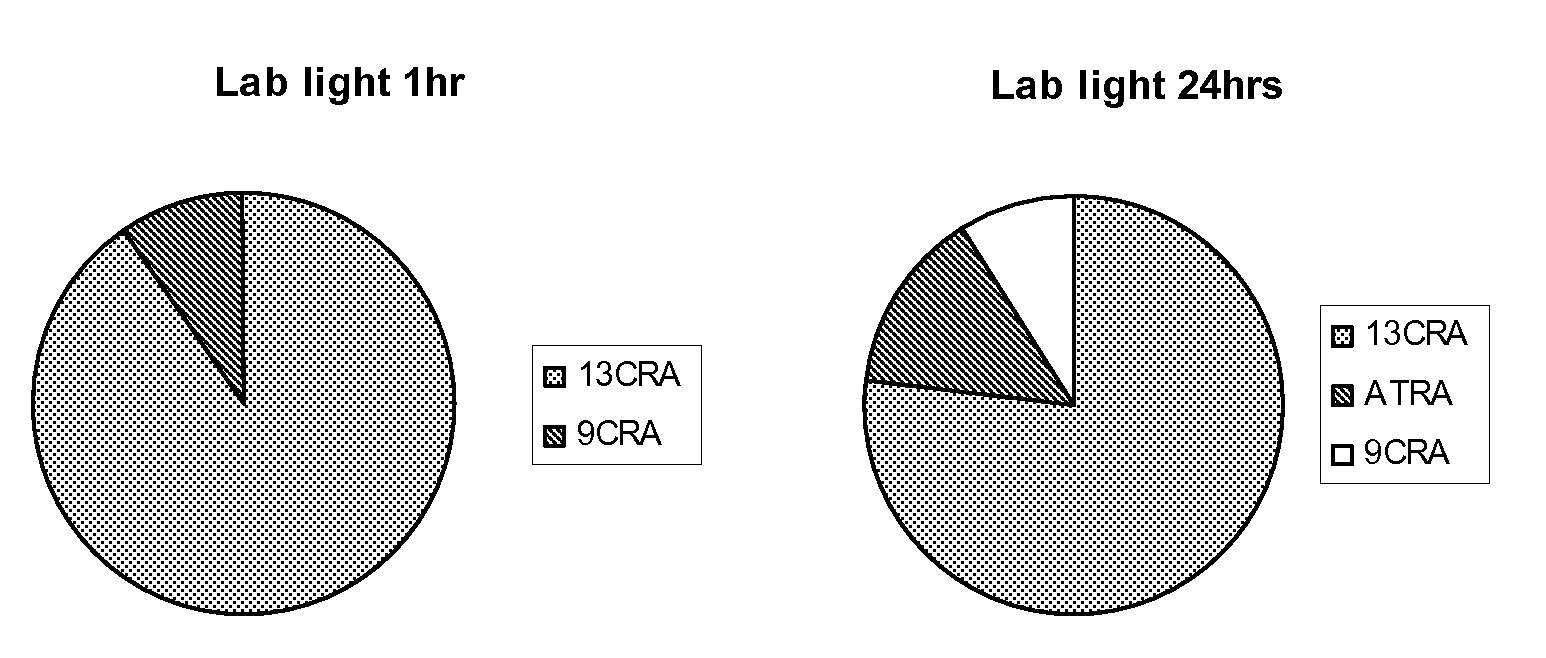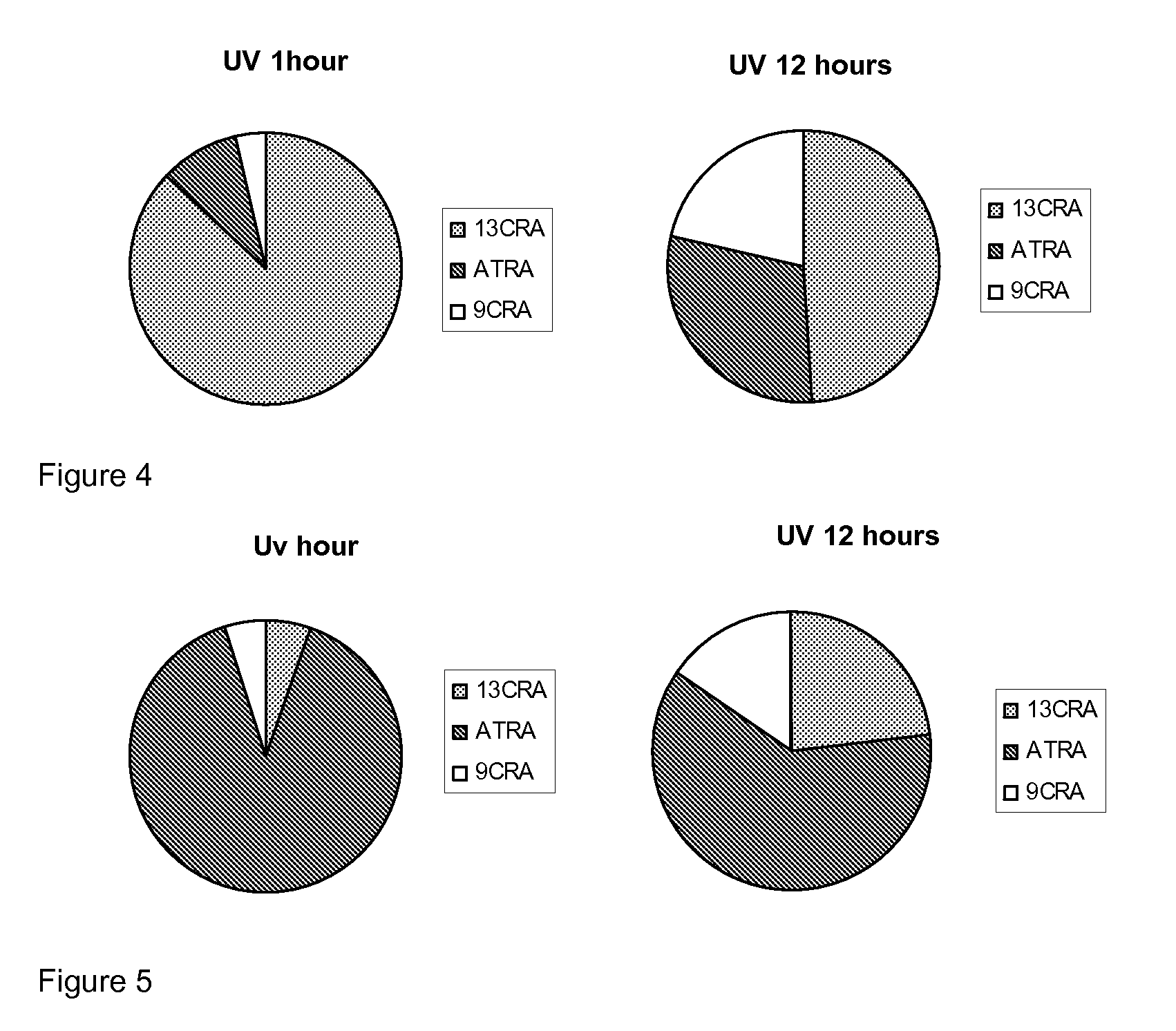Retinoid compounds and their use
a technology of retinoids and compounds, applied in the field of retinoids, can solve the problems of inability to guarantee, temperature sensitive retinoids such as atra, and inability to oxidise readily, so as to improve the stability of compounds
- Summary
- Abstract
- Description
- Claims
- Application Information
AI Technical Summary
Benefits of technology
Problems solved by technology
Method used
Image
Examples
example 1
Synthesis of Compounds
[0137]Compounds 6, 10, 11, 12 and 13 were prepared according to Schemes 1, 2 and 3 supra.
Experimental
[0138]All reactions were carried out under a dry nitrogen atmosphere using standard Schlenk techniques or in an Innovative Technology Inc. System 1 double-length glove box. Glassware was oven dried before transfer into the glove box.
[0139]Hexane and THF were dried over sodium / benzophenone and acetonitrile was dried over CaH2 and all were distilled under nitrogen. The solvent 1,4-dioxane was degassed by 3 freeze-pump-low-cycles. Toluene was dried and deoxygenated by passage through columns of activated alumina and BASF-R311 catalyst under Ar pressure using a locally modified version of the Innovative Technology, Inc. SPS-400 solvent purification system.
[0140]The compound 1,1,4,4-tetramethyl-1,2,3,4-tetrahydro-naphthalene was purchased from Avocado Chemical Company and was dried over CaH2 and distilled. [Ir(μ-Cl)(COE)2]2 (Ent et al, Inorg. Synth. 1990, 28, 90), tr...
example 2
Determination of Physical and Chemical Stability
[0173]Taking into account that naturally occurring retinoids are sensitive and isomerise, we designed, synthesised and purified a number of synthetic retinoid derivatives as described herein, that display improved stability and similar biological activity. We have evaluated the biological activity of these molecules on different types of mammalian stem cell and their ability to modulate the differentiation of these cells.
[0174]In order to test the sensitivity of the natural retinoids, 10 mM samples in either DMSO or deuterochloroform were exposed to either 37° C., laboratory light (approximately 500 lux), white light (approximately 1250 lux) or UV light. Upon isomerisation HNMR spectra of samples were taken and compared to HNMR spectra of pure samples. The % peak intensities from the HNMR spectra were used to quantify levels of the different retinoic acids and any other compounds that may be present.
Retinoic Acids Isomerised at 37° C.
[...
example 3
Determination of Biological Activity
[0185]The biological activity of compounds 6, 10, 11, 12 and 13 were determined by exposing these molecules at various concentrations to different mammalian stem cell systems, namely (1) human pluripotent stem cells; and (2) rat adult neuroprogenitor cells.
Compound Testing on Human Pluripotent Stem Cells
[0186]Tissue development by human pluripotent stem cells closely resembles that which occurs during normal embryogenesis in utero and this cell system is a proven and accepted model of cell differentiation (Przyborski et al, Stem Cells Dev., 2004, 13:400-408).
[0187]The expression of cell surface antigens that are known to change as these stem cells commit to differentiate, was assessed by flow cytometry. Test molecule 10a(i) induced the suppression of the stem cell markers TRA-1-60 and SSEA-3 whilst antigens associated with differentiated tissues, A2B5 and VINIS-53, showed marked increases in expression over the 14 day test period. These changes we...
PUM
| Property | Measurement | Unit |
|---|---|---|
| temperatures | aaaaa | aaaaa |
| temperature | aaaaa | aaaaa |
| temperature | aaaaa | aaaaa |
Abstract
Description
Claims
Application Information
 Login to View More
Login to View More - R&D
- Intellectual Property
- Life Sciences
- Materials
- Tech Scout
- Unparalleled Data Quality
- Higher Quality Content
- 60% Fewer Hallucinations
Browse by: Latest US Patents, China's latest patents, Technical Efficacy Thesaurus, Application Domain, Technology Topic, Popular Technical Reports.
© 2025 PatSnap. All rights reserved.Legal|Privacy policy|Modern Slavery Act Transparency Statement|Sitemap|About US| Contact US: help@patsnap.com



